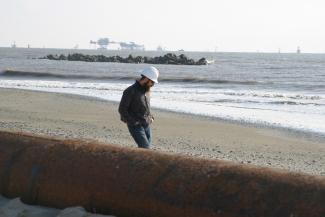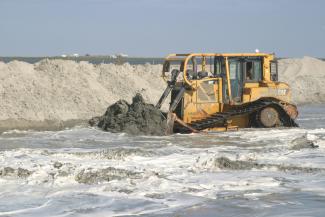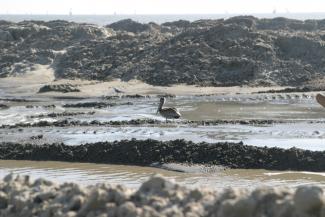Prevention
Strengthening environmental review - BOEM is conducting comprehensive site specific environmental assessments for all exploration and development plans in accordance with the National Environmental Policy Act in order to strengthen the framework designed to ensure that environmental risks are thoroughly analyzed, appropriate protective measures are implemented, and that environmental analyses are transparent and well-understood within the Federal government and by the public and stakeholders.
Focus on science-based decision-making - A new Office of Environmental Programs (OEP), led by a Chief Environmental Officer, was established in 2011. This allows better integration of science into decision-making at every stage of the oil and gas development process and facilitates top-quality research by talented scientists from a range of disciplines.
Improving Worst Case Discharge calculations - Current regulations require the offshore oil and gas industry operators to submit worst case discharge (WCD) calculated volumes and associated data as part of every exploration plan and development plan. BOEM engineers and geoscientists validate the assumptions and calculations and conduct independent analyses of the WCD scenarios included in operators' plans. BOEM defines a worst case discharge for exploratory and development drilling operations as the daily rate of an uncontrolled flow of oil and gas from all producible reservoirs through the open wellbore. BOEM’s worst case discharge model outputs are used by BSEE in reviewing oil spill response plans and making Application for Permit to Drill (APD) decisions.
Improving accuracy in air quality modeling - BOEM announced proposed updated air quality regulations that will more accurately account for and more effectively address emissions from offshore oil and gas activity, effectively ensuring that those activities do not significantly harm the air quality of any state -- giving coastal communities and stakeholders greater confidence regarding expected air quality impacts from OCS activity.
Thorough review of exploration and development plans - Enhanced web-based review of plans has helped ensure that companies are complying with rigorous operational and environmental standards and that BOEM's reviews are efficient and transparent. The bureau is modernizing plan review through web-based applications and has added an evaluation process for reviewing information related to the potential for an oil spill that is submitted to the agency by the industry.
Increasing limits of liability - BOEM has implemented new strategies to hold responsible parties accountable. BOEM has increased the limit of liability for oil-spill related damages from $75 million to approximately $138 million for offshore oil and gas facilities - the maximum allowed under the law - and has established a process for future increases to keep pace with inflation.
Developing shared standards in the Arctic - BOEM and BSEE have published proposed standards specific to the Arctic: to ensure that operators take the necessary steps to thoroughly plan for and conduct safe exploratory drilling operations under unique Arctic conditions.
Restoration
Since 2010, BOEM has leased more than 60 million cubic yards of offshore sand for coastal restoration projects in the Gulf of Mexico including:
- Caillou Lake Headlands (also known as Whiskey Island) - funded by the Natural Resources Damage Assessment Early Restoration Project, excavated nearly 13.4 million cubic yards of high-quality sand from Ship Shoal. The sand, located nine miles offshore on the OCS, was pumped through a temporary pipeline to the project site to construct some 1,100 acres of barrier island habitat.
- Terrebonne Basin Barrier Island and Beach Renourishment Project - funded by the National Fish and Wildlife Foundation (NFWF) out of the Gulf Environmental Benefit Fund, this ongoing project expects to extract 10 million cubic yards of OCS sediment resources from South Pelto blocks on the Ship Shoal sand body.
- Mississippi Coastal Improvements Program - Ongoing Ship Island restoration through a joint effort between BOEM, the National Park Service, the U.S. Army Corps of Engineers Mobile District, and the State of Mississippi utilizing up to 19.6 mcy of OCS sediment. Once complete, this will be the largest BOEM coastal restoration project to date.
In addition to the projects above, there have been several other large projects, particularly in Louisiana, that collectively used approximately 17.1 million cubic yards of OCS sediment. These include:
- Caminada Headland Beach and Dune Restoration Increments I and II;
- Cameron Parish Shoreline Restoration;
- Raccoon Island Backbarrier Marsh Restoration; and
- Pelican Island Restoration.
- Long-term ecosystem health and restoration - BOEM is a key federal partner in carving out the goals of the RESTORE Act. Through research and coastal restoration expertise, BOEM contributes to the framework for a long-term program to restore the natural resources of the Gulf of Mexico and Gulf Coast region.
Preparedness
- Since 2010, BOEM has commissioned close to a dozen studies to understand the impacts of DWH and environmental research focused on Gulf of Mexico Monitoring, Recovery and Renewal - BOEM has focused on long-term monitoring, recovery and renewal of the Gulf of Mexico by conducting studies with federal, university and industry partners. These studies investigate impacts of the oil and dispersants on marine resources, develop state-of-the-art tools for modeling oil spill transport, and analyze social and economic recovery from oil spill impacts. They include but are not limited to:
- Impact on Gulf Coast residents, communities, and businesses in the first 20 months after the oil spill
- Aerial surveys to predict the trajectory of the oil slick
- Impact of the spill on coral habitats
- Oil spill modeling study
- Using social science to assess the impact of the oil spill on tourism
- Investigating the impact on deepwater shipwreck sites
- Fate and movement of spilled oil in surface waters
- Analysis of the DWH spill impacts on the seafood industry
- Assessment of oil spill impacts on coastal archaeological sites
Since 2010, BOEM has placed a renewed emphasis on public input and scientific analysis which are critical to safe exploration and development of offshore resources - Public comment is solicited in our environmental review programs for both oil and gas and renewable energy proposals. Plans submitted by industry are subject to rigorous scientific review to ensure that environmental safeguards are the foundation of all offshore energy development.




